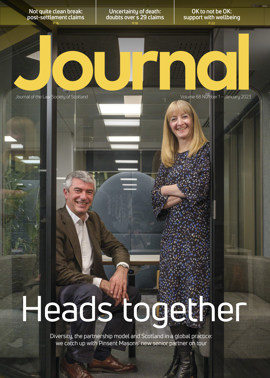SD v Grampian: the “duty nexus” continued
Manchester Building Society v Grant Thornton [2021] UKSC 20 (“MBS”) and Khan v Meadows [2021] UKSC 21 (“Khan”) were recently applied by the Outer House of the Court of Session in SD (LD's Legal Representative) v Grampian Health Board [2022] CSOH 63 (“SD”), one of the latest cases to test the revamped SAAMCO principles.
Background
During childbirth, SD's son suffered severe acute asphyxia as a result of compression of the umbilical cord. He was consequently born with quadriplegic dyskinetic cerebral palsy. SD claimed that her son's disabilities were ultimately caused by the negligence of various members of hospital staff, including certain midwives working in the antenatal ward. It was accepted that, had the child been delivered at an earlier stage, he would not have suffered the injuries that he did. SD alleged that the hospital staff were liable for those injuries as the midwives had negligently delayed the induction and then the obstetrician had negligently delayed the delivery.
Legal arguments
Grampian Heath Board admitted in its pleadings that there was a direct relationship between the time of delivery and the harm caused to the child. Therefore, it did not attempt to put forward any scope of duty defence on behalf of the obstetrician (who ultimately delivered the child). However, it did advance such a defence in respect of the midwives.
The health board relied on the refined SAAMCO principles set out in the six-part test in MBS/Khan to argue that preventing the specific harm which the child eventually suffered was not something that fell within the scope of the midwives' duties. It accepted that strict factual causation could be shown (on a simple “but for” analysis), as the child would not have suffered any harm had he been delivered at an earlier stage (which would have happened had the induction not been delayed). However, it argued that there was no sufficient nexus between the alleged breaches of duty of the midwives and the harm suffered by the child, as this harm was attributable to events when SD was in labour, about to deliver.
Although the midwives provided care in the antenatal unit, they had no direct involvement with the delivery itself (i.e., at the point when the harmful event occurred). While SD was in their care, the midwives could not have predicted what would eventually happen during the birth, so preventing that outcome was not something which fell within the scope of their duties.
SD argued that there was a direct causal link between the delay in induction (allegedly caused by the midwives) and the harm suffered by the child, such that the scope of duty question simply did not arise. In other words, the alleged negligence of the midwives directly exposed SD and her son to the specific harm and therefore the principles set out in MBS/Khan were irrelevant.
Decision
Lady Wise ultimately found that SD had failed to establish breach of duty, but set out what her opinion on scope of duty would have been had her decision fallen the other way. Lady Wise accepted that no scope of duty issue arose in relation to the obstetric case. However, regarding the alleged breaches of duty on the part of the midwives, she would have held that the harm suffered by the child was “too remote” from anything that occurred in the antenatal ward for there to be the necessary sufficient nexus between any breach of duty on the part of the midwives and the eventual adverse outcome. Grampian Health Board would therefore have been able to rely successfully on MBS/Khan and establish that preventing the harm in question did not fall within the scope of the midwives' duties.
Wider implications
Since the Supreme Court's ruling in MBS/Khan, courts have been asked to focus on the purpose of a professional's duty (rather than shoehorn cases into “information” or “advice” categories). Courts will now, therefore, closely consider the nuances of a professional's duties to consider what outcomes and risks the professional could have been expected to predict and protect against. Therefore, defenders who can clearly show what precisely is encompassed within the scope of their duties may now find a defence for liability for negligence more easily than they might have prior to MBS/Khan. The “duty nexus” defence which the midwives relied on in this case would not have been as readily available prior to the Supreme Court judgment in MBS.
The midwives escaped liability by focusing on the particular scope of their duties. This serves as a reminder to all professionals of the importance of the scope of their duties. Professionals in all private sectors should be careful to clearly set out the scope of any work to be carried out for clients in order to clearly define the extent of their duties. This could be in a letter of engagement and/or in an organisation's terms of business.
Regulars
Perspectives
Features
Briefings
- Civil court: Costs – the tail that wags the dog
- Licensing: Keeping alcohol out of sight
- Planning: A framework for sustainability?
- Insolvency: When is a creditor not a creditor?
- Tax: A new, improved autumn statement?
- Immigration: First stop Rwanda?
- Scottish Solicitors' Discipline Tribunal: January 2023
- Civil court: Expenses – barred by delay?
- Property: Transparency, human rights and the registers






